ARTH100: Unit 7 - The Early Modern Period and the Global “Renaissance” 1400 CE - 1650 CE
1/24
There's no tags or description
Looks like no tags are added yet.
Name | Mastery | Learn | Test | Matching | Spaced |
|---|
No study sessions yet.
25 Terms
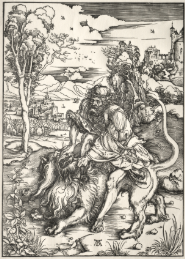
Albrecht Durer,
German artist from the Renaissance period
Known for impressive textural and tonal work in woodcuts, as seen in “Samson and the Lion” where he developed tone by carving thin lines to represent shadows
Created a multi-sheet woodcut commissioned by the Holy Roman Emperor, demonstrating a collaborative effort and aspects of early capitalism in art production and distribution

Ming Dynasty & Tang Yin
Engaged in cultural and art exchanges with the West through trade routes like the Nan Silk Road the more developed Maritime Silk Road
Initially there was a strict Maritime prohibition policy, but later, European traders arrived, leading to the exchange of goods, Western art, and ideas like Christianity
Chinese traditional arts such as calligraphy, painting, and porcelain were influenced by European art, and vice versa
Some argue the landscape in the Mona Lisa has Chinese inspired elements
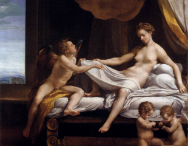
Danae
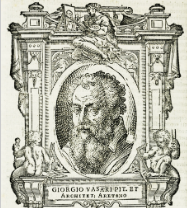
La vite de’ piu eccellenti pittori scultori e archetettori
Book written by Giorgio Vasari in Florence
Introduction to biographies of painters, sculptors, and architects, telling the story of who Vasari considered the greatest artists of the time, though it was biased and excluded some, notably women
Significant insight into the lives and perceived importance of Renaissance artists
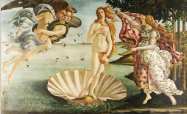
The Birth of Venus, Sandro Botticelli
Distinctly unreligious (secular) work that draws inspiration from Greco-Roman antiquity
Embodies Renaissance aesthetics through its symmetry, perspective, and harmony, and reflects the period’s interest in humanism
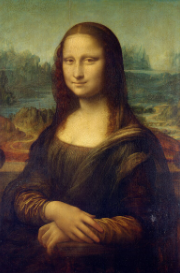
Mona Lisa, Leonardo da Vinci
Some suggest the landscape behind resembles common stone forms in Chinese landscape paintings, and it employs the common blank space technique
During this period, wealthy merchants would commission portraits like this as a display of status and position
Interestingly, was never delivered to the Patron
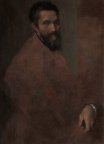
Attributed to Daniele da Volterra, Michelangelo Buonarroti
He was highly esteemed by his contemporaries and was called “the divine one: because his art was perceived as otherworldly
After his death, over 100 portraits and numerous biographies were created about him, indicating his immense fame and the emerging idea of the artist as “genius”
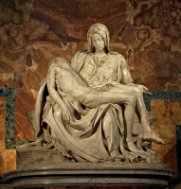
Michelangelo, Pieta
His first large public project, carved from a single piece of stone
Stated his aim was to create the most beautiful work in Rome, and spent 6 months finding the perfect piece of marble
The “Pieta” represents and compassion of Mary for her son, conveying anguish and sadness while making the hard marble appear like soft flesh

Michelangelo, David
The figure of David symbolized the powerless fighting the powerful and represented Florence’s status in its conflicts with other powers
The marble used was a white piece that another artist had previously failed to carve
Originally intended to be placed high up on the buttress of the Duomo (cathedral), it was never placed there because people wanted to see it at ground level

Michelangelo, Celing of the Sistine Chapel
Commissioned by Pope Julius II to paint a fresco
Instead of the originally planned ceiling dotted with stars, he proposed and executed scenes from the Old Testament, divided by fictive architectural elements
The sheer scale and artistry of the ceiling attracted many artists who traveled to see it

Michelangelo, Creation of Adam, ceiling of the Sistine Chapel
Painted after he took a year long break, and the works created afterward exhibit a different style characterized by only essential narrative elements, a focus on musculature, and the use of space

Madonna of the Long Neck, Parmiglanino
Considered not harmonious or well-balanced, featuring elongated figures, including a child that appears lifeless, and a seemingly random pillar
It is often used ass an example of Mannerist art, characterized by its anticlassical style and contradictory elements
Painted for a funerary chapel
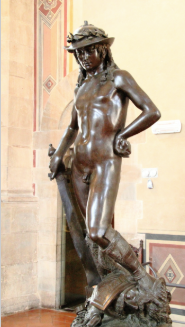
Bronze

Blue & White Pottery
Created in China and highly sought after in the West
The popularity eventually led Western factories discovering the technique and producing their own versions
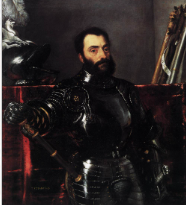
Portrait of Frances co Maria Della Rovere
One of two portraits of the Duke and Duchess and is argued to exemplify the ideal qualities of men during this period
The Duke is depicted in armor, holding a weapon, and presented as powerful and authoritative
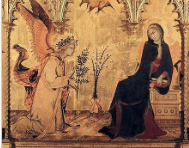
Simone Martini, The Annunciation
Reflects the feminine ideal in Europe, which was largely derived from the Virgin Mary
Emphasized qualities such as being virginal, domestic, and calm, relegating women primarily to the role of mother and valuing virtues like chastity and motherhood
The term Renaissance
means re-birth and refers to the rediscovery of classical antiquity
During the early modern period:
City-states in Italy helped to bring about the new Renaissance, or rebirth of classical ideas
This was aided by the interest in Greek and Roman texts, which were translated in this tie
This engagement with the scholarship and ideas of the past is called humanism and it placed the human at the center of society rather than the church
The Christian church also commissioned many iconic works from this period
It was also aided merchants and bankers who supported artists and scholars through patronage
How did they make their vast welath?
While the Italian Renaissance is the birthplace of a lot of great art, it is also he place where capitalism was born,
ie. “an economic system characterized by private or corporate ownership of capital goods and the distribution of goods that are determined mainly by competition in a free markey”
Initially, the Ming dynasty had a strict maritime prohibition policy to limit foreign influence
This changed in the early 26th century, and European traders began to arrive and sought out goods to import while introducing Western art and ideas, including christianity
Chinese traditional arts such as calligraphy, painting, and porcelain were influenced by European att
In the sam way, art from Europe was influenced by Chinese art being imported
Some have argued that the Mona Lisa has a landscape inspired by Chinese painting
Most influential was Chonese pottery which was highly sought agter and collected in the West, especially blue-and-white porcelainThe secret of this technique was finally revealed and western factories began to produce their own porcelain
Printmaking
Revolutionized the production of images, helping to spread art and visual culture to the people,
arrived in Europe late, as technologies moved from East Asia to Central Asia and finally Europe
Was as life-changing as the advent of photography in the 19th century or digital media in the late twentieth
Allowed artists to make multiples and they often partnered with printshops to commercially produce their work
Allowed for the spread of ideas and information beyond the power of the elites and the Church
The techniques of printmaking popular during the modern period included:
Relief and intaglio approaches
Relief methods like the woodcut came to Europe from Asia and became the most effective method of illustrating texts made with movable type, such as from the Gutenberg press
A woodcut is produced by carving into the block of wood and then inking the raised surface of the matrix, which will result in a mirror impression of the composition when the block is pressed onto a sheet of paper
Intaglio process of engraving emerged in Germany in the 1430s and involves scratching and incising into a copper plate which is then coated with ink and wiped clean, leaving only ink in the carved out section
The matrix is then run through the printing press with a damp sheet of paper
The pressure from the press pushes the paper into those grooves and pick up the ink, resulting in a mirror impression of the image engraved on the copper plate
Renaissance art
Includes both secular and religious art, is often associated with painting and sculpture but in its time included all sort of decorative and functional objects
Celebrated the ideas and ideals of classical antiquity
Was not made to be purely aesthetic of beautiful but instead had commemorative, educational ,or fictional purposes
Was largely made possible by the financial support of wealthy patrons, from the Church, political, and mercantile elites
Renaissance artists:
were deeply interested in naturalism and sought to represent the human body as accurately as possible
Were inspired by Alberti’s ideas on linear perspective to paint scenes that were more realistic through three demensionlaity
Argued that their work—which was based on science and math— was a product of their intellect just as much as their hands
Wanted to have the same status as intellectuals and philosophers,
Unlike the medieval craftsmen that came before term, began to be perceived as individuals with great talent or “genius”
The female nude is the renaissance
was meant for the enhoyment of the male gaze
Patronage in the Renaissance Italy
Was meant to demonstrate important renaissance themes
Possessing the ancient world through the collection of antiquities, demonstrating erudition through the acquisition of classical narratives
Fashioning an identity through portraiture and symbols
Fulfill a devotional or religious need and to expiate the patron’s sins
Inspire civic responsibility or to demonstrate that members of a particular community performed their duties properly